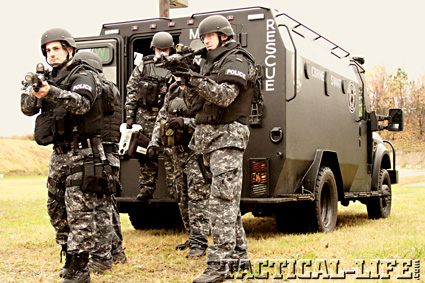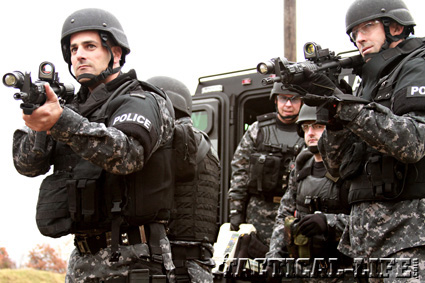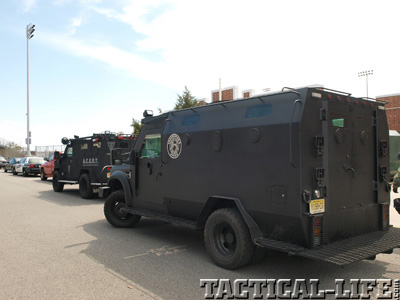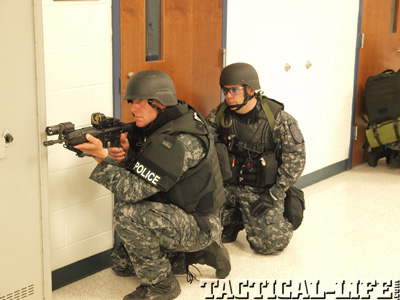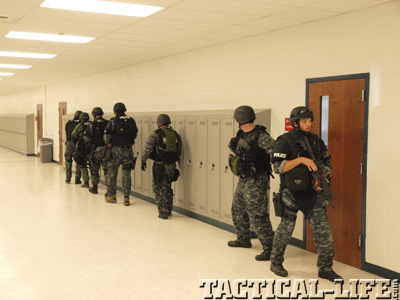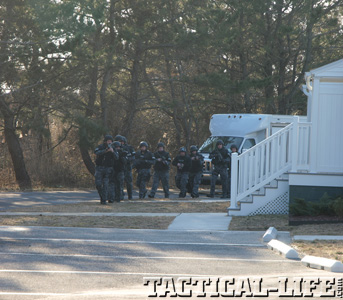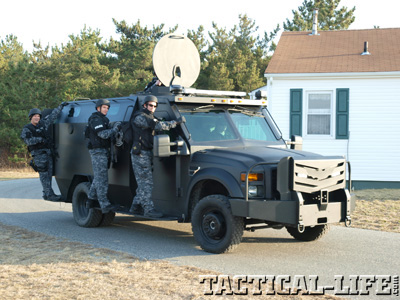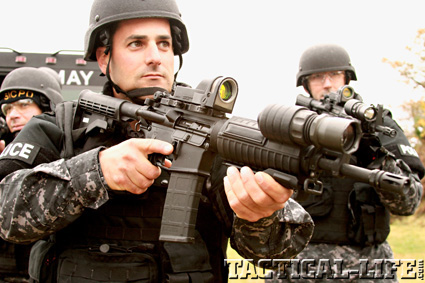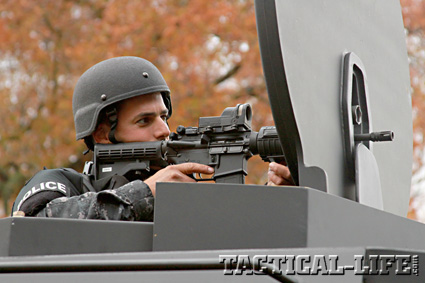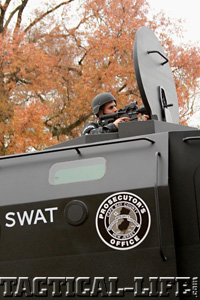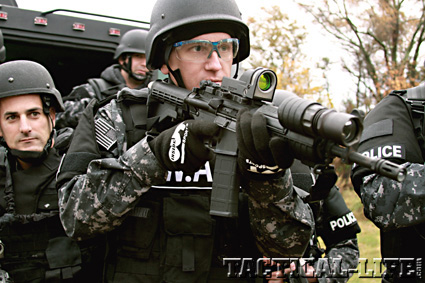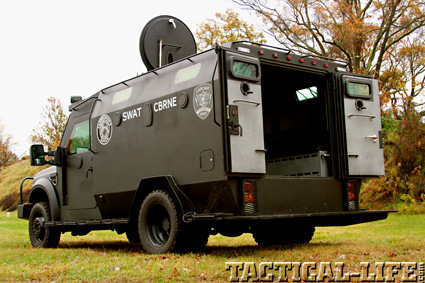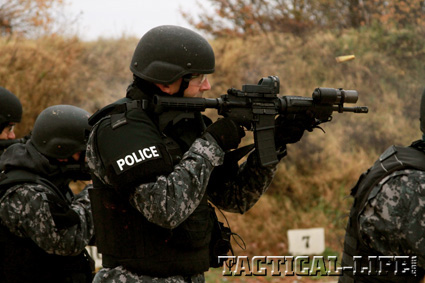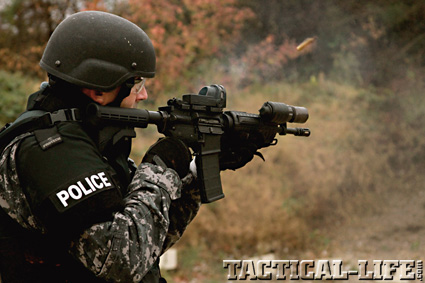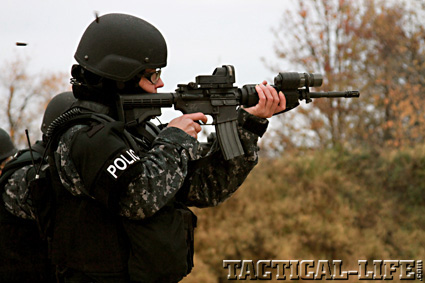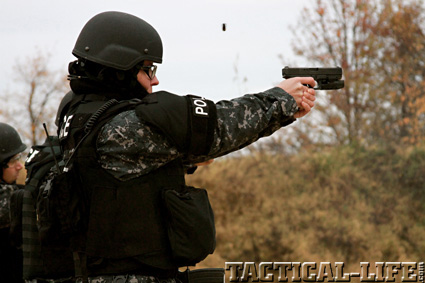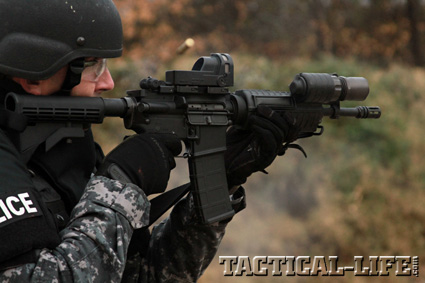Long sandy beaches and historic Victorian homes define Cape May, the “Nation’s Oldest Sea Shore Resort,” located at the southern tip of the New Jersey shore. It’s a community often regarded as entirely crime-free, but each summer, when its population swells with thousands of visitors, the calm quickly disappears and crime rates soar, stretching the law enforcement agencies responsible for maintaining the peace. Responding to the worst and most dangerous criminal acts, regardless of the season, is Cape May County SWAT. First established in 2006, the part-time regional tactical team pools the resources and manpower of nine separate departments to create a combined group of 35 men and women responsible for high-risk law enforcement operations throughout the county’s 620 square miles.
Situated on a peninsula extending into Delaware Bay, Cape May County SWAT’s area of operation is divided between a heavily forested mainland and the more urban island communities situated along the Atlantic coast. The geography and disparate terrain requires a division of the team into two squads, Mainland and Island, though they can seamlessly combine when required to bring their full number to bear. Operating in predominantly rural areas, the Mainland team dedicates hours to tracking fugitives through dense foliage and open terrain, while the Island team focuses more on the close-quarters-battle (CQB) tactics necessary to move safely through the county’s many multi-story beachfront hotels and apartment buildings. The squads routinely train together for critical incidents such as active-shooter and hostage situations, which would necessitate the callout of the entire team. Much of the agency’s current caseload relates to narcotics warrants, served in response to the importation of heroin, cocaine and marijuana brought from Philadelphia and New York to cater to the visitors who descend on the county every summer.
Weapons & Tactics
Advertisement — Continue Reading Below
Every officer selected for the team attends the five-day SWAT I course at the U.S. Training Center in Moyock, North Carolina, where candidates develop the marksmanship and tactical skills necessary for CQB. Many will later complete the company’s SWAT II course, which focuses on the more advanced tactics and techniques required for hostage-rescue missions. In addition to performing regular duties with their parent departments, officers joining the county team are expected to undergo a minimum of 12 hours of SWAT-specific training each month and participate in up to three annual exercises involving the full team. Each officer uses his or her department-issued sidearm, nearly all of which are .45-caliber Glock 21s, and are provided with a Colt M4 Commando by the county. Chambered for 5.56mm NATO ammo, this select-fire rifle has been adopted by tactical teams throughout the country because of its power, light weight and short overall length—features that provide operators with the lethality, mobility and speed required to clear interior areas.
Fitted to every county-procured rifle is a Meprolight M21 self-powered reflex sight, which provides constant, all-light aiming capability without batteries. Using a tritium light source in darkness and a fiber-optic light collector during the day, the M21 features a 4.3-MOA bullseye triangle reticle that allows for rapid and parallax-free target acquisition with both eyes open. An additional modification is SureFire’s M500A weapon-mounted light, which replaces the original handguard and features a 9-volt, shock-isolated incandescent lamp with an output of 125 lumens. Three beam switches are integrated into its forend, affording the shooter options for activating the light based on their individual preference, including a constant-on rocker, a momentary-on pressure pad, and a system-disable rotary switch.
To promote uniformity and create an air of intimidation conducive to suspect compliance, officers are provided with BDU-style uniforms in a dark digital camouflage pattern that includes a combat-style shirt with uniform rip-stop nylon sleeves and a cotton-acrylic chest and back, which mitigate the degree of heat experienced when wearing a full kit. For ballistic protection, officers wear a MOLLE-compatible Protech Titan Assault Enhanced plate carrier with NIJ Level IIIA soft armor under Level IVA ceramic plates, the latter being included to stop the rifle rounds against which soft Kevlar, designed only to protect against handgun calibers, is insufficiently protective. The carrier supports user customization and offers detachable yoke, groin, bicep and throat protectors. Protech Delta 4 Level IIIA ballistic helmets, weighing less than 3 pounds and secured with an adjustable three-point retention chinstrap, complete the armor system.
Advertisement — Continue Reading Below
Multi-Mission Capabilities
After a probationary period, those SWAT officers seeking additional challenges and responsibilities are provided opportunities to fill unique roles, including grenadier, breacher and sniper. The team’s grenadiers are responsible for the deployment of 37mm munitions, including smoke, gas and rubber rounds, as well as distraction devices that can be command-detonated using a bang stick. Breachers rely on mechanical methods like rams, halligan tools, sledge hammers and pneumatic spreaders to create entry points for the team, though more and more officers are becoming proficient with explosive methods, such as circle charges, which are placed against reinforced doors and walls. A four-man sniper element with shooter-and-spotter pairs provides standoff cover for entry teams and precision fire for hostage situations. Each carries a bolt-action Remington 700P .308 fitted with a Leopold Mark 4 10x40mm M3 telescopic sight, which allows for the effective engagement of targets out to 1,000 yards. When assigned, medics play a vital role and are available to care for downed officers, victims and suspects.
For transportation and cover, the county, using funds from a Department of Homeland Security grant, procured an Armored Group Ballistic Armored Tactical Transport (BATT) with a top speed of 80 miles per hour and a 12-man capacity. Its metal plating is capable of stopping .50-caliber rounds, protecting its driver and those in the personnel compartment until the order is given to dismount, at which time the team exits in two parallel lines from the rear doors. A turret hatch on the roof provides additional cover and a protected firing position for the team’s snipers
.
Another capability available to Cape May SWAT is a mobile Packbot 510 robot by Robotex. Though often regarded as a mechanism specifically designed to handle explosive devices, the Packbot is employed in a variety of support roles, typically to help limit the risk to officers. Operationally, the robot has served to conduct close-in surveillance of targeted structures and deploy throw-phones to barricaded and emotionally disturbed suspects. In training, the Packbot is used successfully to investigate suspicious packages and survey contaminated environments.
Advertisement — Continue Reading Below
Anti-Terror Task Force
Following SWAT standards created by the National Tactical Officer’s Association (NTOA), Cape May County SWAT excels at incorporating into its program the latest tactics and gear. County Prosecutor Robert Taylor, his Special Operations and Planning Section Supervisor Lieutenant Ken Super and Joe Murphy, a sergeant with the Wildwood Police Department and commander of the SWAT team, have done an exceptional job creating a forward-thinking team that is well prepared to counter any threat and that continues to adapt to developing trends in criminal and terrorist tactics. Now working to create a chemical, biological, radiation and nuclear (CBRN) capability, and to develop even higher standards of marksmanship and tactics through formal training, Cape May County SWAT is poised to become a model for others agencies both in the state and across the nation.
